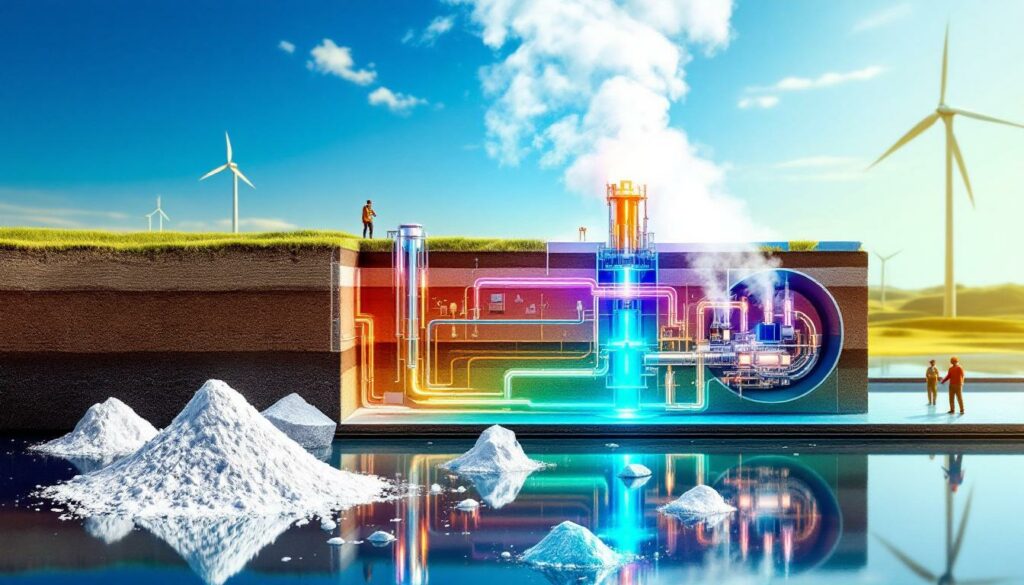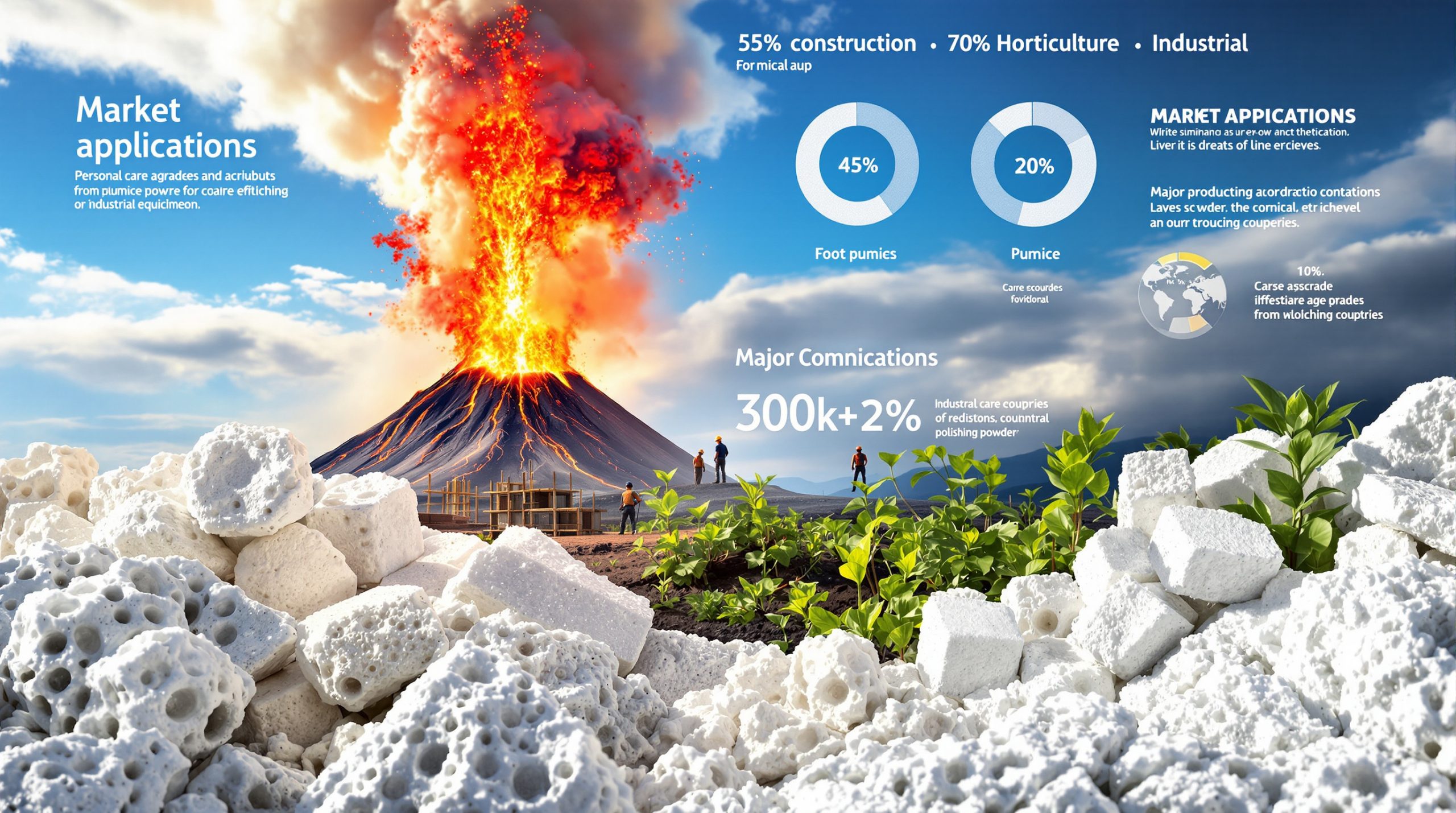What is Direct Lithium Extraction (DLE) Technology?
Direct Lithium Extraction (DLE) represents a revolutionary advancement in how we obtain lithium, the essential metal powering our clean energy transition. Unlike traditional methods that rely on extensive evaporation ponds or environmentally disruptive hard rock mining, DLE technology extracts lithium directly from geothermal brines using specialized chemical processes.
DLE operates through selective adsorption or ion exchange systems that target lithium ions while leaving other elements behind. This precision allows for significantly reduced land footprint, minimal water consumption, and substantially faster extraction times compared to conventional methods that can take 18-24 months for evaporation.
"DLE technology represents a paradigm shift in lithium production, enabling faster extraction with a fraction of the environmental impact of traditional methods."
The environmental advantages are substantial: DLE typically reduces water usage by up to 90% versus evaporation ponds, requires minimal land disturbance, and produces fewer waste products. These benefits position DLE as a critical technology for sustainable lithium production as global demand continues to surge with electric vehicle adoption.
Understanding the DLE Process
The core principle behind DLE involves passing lithium-rich brine through specialized materials that selectively capture lithium ions. This process typically follows several key steps:
- Brine extraction – Pumping lithium-rich brine from underground reservoirs
- Pre-treatment – Removing impurities that might interfere with lithium capture
- Selective adsorption – Passing the brine through engineered materials that bind only to lithium
- Lithium recovery – Washing the lithium from the adsorption material with a fresh solution
- Concentration – Processing the lithium-rich solution to create battery-grade lithium products
Unlike traditional evaporation methods that rely on large ponds and weather conditions, DLE works continuously and can be housed in compact processing facilities. The technology also allows for the processed brine to be reinjected into the reservoir, maintaining hydrological balance and reducing environmental impact.
Recent technological advances have improved lithium recovery rates from below 50% to over 90% in some systems, significantly enhancing the commercial viability of previously uneconomical lithium sources. For those interested in recent developments, examining lithium brine insights can provide valuable market perspectives.
The Smackover Formation: A Lithium Treasure
The Smackover Formation represents one of North America's most promising lithium resources, extending across parts of Texas, Arkansas, and Louisiana. This ancient geological formation consists of Jurassic-age carbonate rocks that contain lithium-rich brines trapped approximately 9,000-15,000 feet beneath the surface.
What makes the Smackover particularly valuable is its remarkably high lithium concentration levels, which range from 150-500 parts per million (ppm) in many areas—significantly higher than the 20-40 ppm found in many South American brine sources. These concentrations, combined with the formation's vast geographic extent, translate to potentially enormous lithium reserves that could help secure domestic supply for decades.
Historically, the Smackover has been known primarily for its oil and gas production, with companies extracting hydrocarbons since the 1930s. This prior development means extensive geological data exists, significantly reducing exploration risk for lithium projects. The region's established infrastructure further enhances development potential.
Current estimates suggest the Smackover Formation could contain over 1 million metric tons of lithium resources, positioning it as a critical asset for America's energy independence goals. As the U.S. currently imports more than 95% of its lithium, developing domestic sources like the Smackover has become a national strategic priority.
How Does Geothermal Energy Enhance Lithium Extraction?
The marriage of geothermal energy with lithium extraction creates a uniquely synergistic process that addresses two critical clean energy challenges simultaneously. This innovative approach leverages naturally heated underground brines as both a lithium source and renewable energy generator.
At temperatures ranging from 160-300°F (70-150°C), Smackover brines contain not only valuable lithium but also significant thermal energy. By tapping into this heat, companies like GeoFrame Energy can power their extraction operations while producing zero-carbon electricity.
This dual-purpose approach transforms what would otherwise be a single-commodity project into a multi-revenue operation that enhances economic viability while dramatically reducing environmental impact.
The Synergy Between Geothermal Energy and Lithium Production
The technical synergy begins with the brine itself. Geothermal brines naturally circulate through hot subsurface rock formations, dissolving minerals including lithium along their journey. When extracted, these hot brines serve two purposes:
- Lithium source: The brine contains lithium ions that can be selectively removed through DLE technology
- Thermal energy source: The heat energy in the brine can generate electricity before the lithium extraction process
This integration creates several key advantages:
- Energy self-sufficiency: DLE facilities typically require significant energy input—a cost that can be eliminated by using geothermal power
- Carbon footprint reduction: Traditional lithium production can generate 15+ tons of CO₂ per ton of lithium carbonate equivalent (LCE); geothermal-powered extraction approaches true carbon neutrality
- Water conservation: Processed brine can be reinjected into the reservoir, maintaining hydrological balance
- Economic efficiency: The dual revenue streams (lithium and electricity) improve project economics
"This project is more than just a lithium production facility—it represents a model for responsible mining that prioritizes sustainability without sacrificing economic viability," explains Bruce Cutright, CEO of GeoFrame Energy.
The circular nature of this process—extracting brine, capturing heat, removing lithium, and returning the brine underground—represents a closed-loop system that minimizes environmental disruption while maximizing resource utilization. This approach aligns with emerging trends in renewable mining power that are transforming the extractive industries.
Zero-Emission Binary Cycle Generators
At the heart of GeoFrame Energy's innovative approach are zero-emission binary cycle generators that convert geothermal heat into electricity without combustion or direct emissions. These specialized systems are perfectly suited for the moderate-temperature brines found in the Smackover Formation.
Binary cycle generators operate on a remarkably efficient principle:
- Hot geothermal brine (typically 160-300°F) passes through a heat exchanger
- The heat transfers to a secondary fluid with a lower boiling point (often an organic compound like isobutane)
- This secondary fluid vaporizes and drives a turbine to generate electricity
- The cooled brine continues to lithium extraction processes
- After lithium removal, the brine is reinjected underground
This technology can generate approximately 0.5-2 megawatts of electricity per well, depending on brine temperature and flow rates. For a typical DLE facility processing 100-200 gallons per minute of brine, this represents enough power to operate the entire extraction facility with excess capacity to sell to the grid.
The electricity generation aspect creates several advantages:
- Grid independence: Operations can continue even during power outages
- Renewable energy credits: Excess power sold to the grid can qualify for additional revenue through renewable energy incentives
- Carbon offset: Each megawatt of geothermal electricity prevents approximately 500-800 tons of CO₂ emissions annually compared to natural gas generation
The zero-emission aspect is particularly important as battery manufacturers and electric vehicle companies increasingly scrutinize the carbon footprint of their supply chains, creating premium markets for low-carbon materials. According to research from the Pacific Northwest National Laboratory, this combined approach could potentially reduce the carbon footprint of lithium production by up to 90%.
What Makes the GeoFrame Energy Project Groundbreaking?
The GeoFrame Energy project represents a confluence of firsts that position it as a potentially transformative development in America's critical minerals landscape. By combining cutting-edge extraction technology with renewable energy production in the resource-rich Smackover Formation, the project addresses multiple strategic priorities simultaneously.
Most significantly, GeoFrame is poised to become the first company to deliver battery-grade lithium carbonate from the Smackover Formation—a milestone with far-reaching implications for U.S. energy security and the domestic EV supply chain.
First Domestic Battery-Grade Lithium Carbonate from Smackover
The production of battery-grade lithium carbonate from the Smackover Formation represents a critical milestone in building a resilient domestic lithium supply chain. Battery-grade lithium carbonate must meet extraordinarily strict purity requirements—typically 99.5% or higher—with strict limits on impurities like sodium, calcium, magnesium and heavy metals that can impair battery performance.
Achieving these specifications from Smackover brine requires overcoming several technical challenges:
- Handling the formation's high bromide content
- Managing calcium and magnesium interference
- Developing specialized purification processes for the unique brine chemistry
When operational, the project is expected to initially produce 5,000-10,000 metric tons of battery-grade lithium carbonate annually during the demonstration phase, with potential for significant scaling in subsequent development phases. This production level would represent approximately 5-10% of current U.S. lithium demand—a meaningful contribution to domestic supply.
The strategic importance cannot be overstated. Currently, the U.S. produces less than 1% of global lithium supply despite having significant resources. With lithium demand projected to increase 4000% by 2040 according to the International Energy Agency, developing domestic sources has become a national security priority.
"GeoFrame Energy's innovative approach will help lead the US' domestic lithium production while showcasing a sustainable model that others can follow," notes Bruce Cutright, underscoring the project's significance beyond mere production volumes.
The advances in battery‐grade lithium refining technology have been critical to making projects like this commercially viable across various geographies.
Halliburton's Role in the Project Development
Halliburton's involvement brings world-class expertise in subsurface operations that significantly de-risks the project's technical execution. As one of the world's leading oilfield services companies, Halliburton brings specialized capabilities in several critical areas:
- Well planning and design optimized for sustained brine production
- Drilling technologies adapted from oil and gas applications
- Production management systems for long-term resource optimization
- Reservoir characterization to maximize resource recovery
Duane Sherritt, VP of Low Carbon Solutions at Halliburton, explains: "Halliburton's 100-year legacy of well expertise, combined with our decades of experience in the Smackover Formation, makes us the best candidate to ensure this innovative project succeeds."
This partnership highlights an important trend: the convergence of traditional energy expertise with critical minerals development. Halliburton's extensive experience with the geological complexities of the Smackover Formation—gained through decades of oil and gas operations—provides unique insights that would take years for newcomers to develop.
The company's involvement also signals growing recognition within traditional energy services companies that the energy transition represents significant business opportunities. By leveraging existing capabilities in new markets, companies like Halliburton are positioning themselves as enablers of clean energy technology while creating new revenue streams.
How Will This Project Impact the US Lithium Market?
The GeoFrame Energy project arrives at a pivotal moment for the U.S. lithium market, which currently faces significant supply challenges amid exploding demand. As electric vehicle adoption accelerates and energy storage deployments multiply, the impact of domestic lithium extraction and geothermal energy projects extends far beyond the immediate market to affect national security, manufacturing competitiveness, and climate goals.
Domestic Lithium Production Landscape
The current U.S. lithium production landscape is characterized by stark supply-demand imbalance. Despite being the world's largest consumer of lithium, the U.S. produces only about 1% of global supply, primarily from a single operation in Nevada. This dependence on imports—exceeding 95% of consumption—creates vulnerability in critical supply chains.
The domestic production picture includes:
- Current production: Approximately 2,500 metric tons of lithium carbonate equivalent (LCE) annually
- Projected demand by 2030: 500,000+ metric tons LCE annually for EV and grid storage
- Supply gap: 497,500+ metric tons that must be imported or produced domestically
- Import dependence: Primary reliance on Argentina, Chile, China, and Australia
GeoFrame's project, while not eliminating this gap, represents an important step toward supply diversification. The initial production capacity could potentially supply enough lithium for approximately 150,000-300,000 electric vehicle batteries annually, depending on battery chemistry and size.
Beyond raw numbers, the project's significance lies in demonstrating commercial viability of a new production model that could be replicated across the Smackover Formation and other similar geological settings throughout North America.
The market impact extends to pricing dynamics as well. Domestic production reduces transportation costs and supply chain risks, potentially stabilizing price volatility that has seen lithium carbonate prices fluctuate between $8,000 and $80,000 per metric ton in recent years. This stability is crucial for manufacturers making long-term investment decisions in U.S. battery production facilities.
Economic and Environmental Benefits
The project's dual-purpose nature—producing both lithium and renewable energy—creates a multiplier effect for both economic and environmental benefits that extends well beyond traditional mining operations.
From an economic perspective, the project is expected to generate:
- Direct employment: 75-150 high-skilled jobs during the demonstration phase
- Indirect employment: 300-600 jobs in supporting industries and services
- Tax revenue: Significant local and state tax contributions in East Texas
- Supply chain impact: Support for downstream battery manufacturing investments
- Energy revenue: Income from electricity sales to the regional grid
The environmental advantages are equally compelling when compared to traditional lithium sources:
| Environmental Factor | Evaporation Ponds | Hard Rock Mining | GeoFrame's Geothermal DLE |
|---|---|---|---|
| Water Usage | 500,000+ gallons per ton | 170,000+ gallons per ton | <20,000 gallons per ton |
| Land Disturbance | 3,000+ acres for commercial operation | Large open pits | <10 acres for similar output |
| CO₂ Emissions | 15+ tons CO₂ per ton LCE | 9-15 tons CO₂ per ton LCE | Near-zero with geothermal power |
| Processing Chemicals | High chemical consumption | Acid leaching | Reduced chemical requirements |
| Waste Production | Large salt tailings | Significant rock waste | Minimal solid waste |
The transportation benefits are particularly noteworthy. Lithium imported from South America or Australia travels 7,000-10,000 miles to reach U.S. battery manufacturers, generating significant transport emissions. Domestic production from East Texas reduces this to 500-1,500 miles for most U.S. battery facilities.
Perhaps most significantly, the project's integration of renewable energy generation means it actively contributes to grid decarbonization rather than adding load. This positions the operation as potentially carbon-negative when accounting for displaced fossil generation—a remarkable achievement for mineral production. The focus on sustainable mine reclamation further enhances the project's environmental credentials.
What Does the Project Timeline Look Like?
The GeoFrame Energy project follows a phased development approach designed to validate technology, optimize processes, and minimize financial risk before full-scale deployment. This methodical timeline reflects both the innovative nature of the project and the significant capital investment required for commercial-scale development.
Demonstration Phase Development
The initial demonstration phase represents a critical proof-of-concept stage that will validate both the lithium extraction technology and the geothermal power generation in the specific geological context of the Smackover Formation.
Key milestones in this phase include:
- Late 2025: Begin well construction and drilling operations
- Mid 2026: Complete surface facilities for power generation and lithium extraction
- Late 2026: Initial brine production and processing
- Early 2027: First battery-grade lithium carbonate production
- 2027-2028: Optimization and performance validation
The demonstration phase will involve 2-3 wells reaching depths of approximately 12,000-15,000 feet to access the lithium-rich brine. These wells will be designed to produce 100-200 gallons of brine per minute—sufficient volume to demonstrate commercial viability while limiting capital exposure.
Critical performance metrics during this phase will include:
- Lithium recovery rate: Target >90% lithium recovery from brine
- Product purity: Achieving 99.5%+ battery-grade specifications
- Energy efficiency: Confirming geothermal power output meets or exceeds projections
- Operating costs: Validating economic model and competitiveness
- Environmental performance: Measuring water usage, emissions, and overall footprint
This phase faces several key technical challenges that Halliburton and GeoFrame will need to address:
- Scaling inhibition: Preventing mineral scaling in wells and surface equipment
- Flow assurance: Maintaining consistent brine production rates
- Heat optimization: Maximizing electricity generation from available thermal energy
Ready to Identify the Next Major ASX Mineral Discovery?
Stay ahead of the market with Discovery Alert's proprietary Discovery IQ model, which instantly analyses ASX announcements to identify significant mineral discoveries before they become mainstream news. Explore why historic discoveries can generate substantial returns by visiting our dedicated discoveries page and begin your 30-day free trial today.




